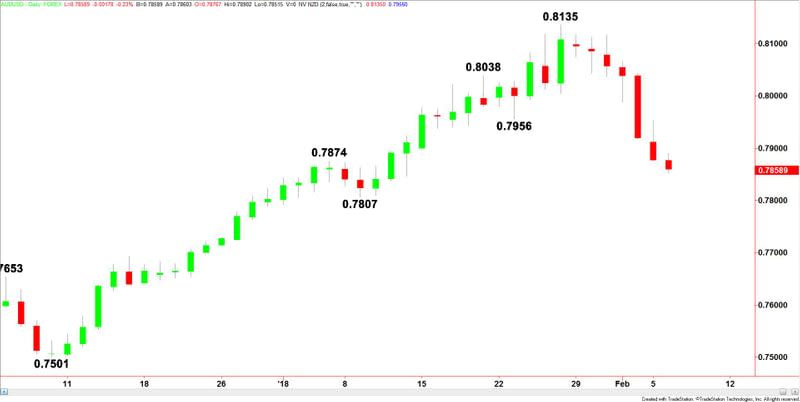AUD/USD and NZD/USD Fundamental Daily Forecast – RBA Leaves Official Rate at Record Low as Retail Sales, Trade Balance Miss Big
A “risk off” trading session on Monday helped drive down the Australian and New Zealand Dollars. Aussie traders were also pressured by uncertainty ahead of the Reserve Bank of Australia’s interest rate decision and reports on retail sales and the trade balance. Kiwi traders had a bank holiday.
The AUD/USD settled at .7877, down 0.0042 or -0.53% and the NZD/USD finished the session at .7265, down 0.0034 or -0.47%.
The U.S. Dollar also firmed on flight-to-safety buying.

Forecast
The Australian and New Zealand Dollars are trading mixed early Tuesday as the rout in the global equity markets continues. This is driving down demand for higher-yielding and commodity-linked assets. Traders are also responding to weaker-than-expected retail sales and trade balance reports. Investors are also responding to the RBA interest rate decision.
At 0423 GMT, the AUD/USD is trading .7843, down 0.0033 or -0.43%. The NZD/USD is at .7279, down .0014 or +0.18%.
Australian Retail Sales
Australia’s December retail sales report came in well under expectations, partially reversing a strong lift in November. According to the Australian Bureau of Statistics (ABS), sales fell by 0.5% in seasonally adjusted terms, missing forecasts for a smaller decline of 0.2%.
Offsetting some of the weakness, November’s stellar gain of 1.2% was revised higher to show an increase of 1.3%.
“There were falls for household goods retailing (2.6%) and other retailing (1.8%) following strong rises in November,” said Ben James, Director of Quarterly Economy Wide Surveys at the ABS.

Australian Trade Report
Australia’s December trade report also came in well below market expectations, continuing the pattern seen in recent months.
According to the Australian Bureau of Statistics (ABS), a deficit of $1.358 billion was recorded in seasonally adjusted terms, far below the $200 million surplus expected by economists.
November’s trade deficit, initially reported at $628 million, was revised to show a small surplus of $36 million, partially offsetting the bad December result.
Exports rose by 1.6% to $32.465 billion over the month, outpaced by a mammoth 6% increase in imports, which rose to $33.823 billion in seasonally adjusted terms. The import figure was the largest on record.
RBA Interest Rate Decision
The Reserve Bank of Australia left the official cash rate on hold at a record low 1.5 percent at its first meeting of the year, citing continuing concerns about weak household consumption.
The central bank also said data over the summer had been consistent with its central forecast for gross domestic product growth to pick up to average a bit over 3 percent over the next couple of years.
“The low level of interest rates is continuing to support the Australian economy,” Governor Philip Lowe said in a statement on Tuesday.
“Further progress in reducing unemployment and having inflation return to target is expected, although this progress is likely to be gradual.”
However, the RBA noted that the outlook for household consumption was a “continuing source of uncertainty”, with household incomes growing slowly and high debt levels.
This article was originally posted on FX Empire

 Yahoo Finance
Yahoo Finance 